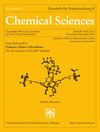Metallkomplexe mit Guanidinderivaten als Liganden: Kristallstrukturen von [Zn(cnge)2(SCN)2] · 2H2O und Zn(eoge)Br2 (enge = Cyanoguanidin; eoge = 1-Ethoxyiminomethylguanidin)
IF 0.8
4区 化学
Q4 CHEMISTRY, INORGANIC & NUCLEAR
Zeitschrift Fur Naturforschung Section B-A Journal of Chemical Sciences
Pub Date : 1996-01-01
DOI:10.14279/depositonce-7619
引用次数: 0
Abstract
Crystals of |Zn(cnge)2(SCN)2]-2H20 (1) were obtained by evaporation of an aqueous solution of Z n(S04)-7H20 , KSCN, and cyanoguanidine. Crystals of Zn(eoge)Br2 (2) were obtained by reaction of ZnBr-. and cyanoguanidine in ethanol/water. Both compounds are monoclinic, space group C2/c, 1: Z = 4, a = 1919.6(7), b = 467.3(2), c = 1838.5(6) pm, ß = 112.99(3)°, 2: Z = 8, a = 1799.5(6), b = 878.7(2), c = 1367.2(5) pm, ß = 101.52(3)°. In 1 each Zn is bonded to two cyanoguanidine molecules and via the N atoms to two NCS groups. Intermolecular hydrogen bonds lead to chains along the «-axis, and these chains are again connected via hydrogen bonds to the two crystal water molecules. In the course of the formation of 2, the cyanoguanidine reacted with the ethanol to form 1-ethoxyiminomethylguanidine. This ligand forms chelate rings with the Zn atoms, which are tetrahedrally coordinated by the two imino N atoms of the ligand and by two bromine atoms.Metallkomplexe由Guanidinderivaten Liganden: Kristallstrukturen [Zn (cnge) 2 (SCN)]·2H2O和Zn (eoge) Br2 (= Cyanoguanidin密切;加里基= 1
通过Zn(S04)-7H20、KSCN和氰胍的水溶液蒸发得到|Zn(cnge)2(SCN)2]-2H20(1)晶体。用ZnBr-反应得到Zn(ege)Br2(2)晶体。和乙醇/水中的氰胍。这两个化合物都是单斜的,空间群C2/c, 1: Z = 4, a = 1919.6(7), b = 467.3(2), c = 1838.5(6) pm, ß = 112.99(3)°,2:Z = 8, a = 1799.5(6), b = 878.7(2), c = 1367.2(5) pm, ß = 101.52(3)°。在1中,每个Zn与两个氰胍分子结合,并通过N原子与两个NCS基团结合。分子间氢键形成沿“-”轴的链,这些链又通过氢键连接到两个水晶体分子上。在生成2的过程中,氰胍与乙醇反应生成1-乙氧基亚胺甲基胍。该配体与锌原子形成螯合环,锌原子与配体的两个亚氨基氮原子和两个溴原子呈四面体配位。
本文章由计算机程序翻译,如有差异,请以英文原文为准。
求助全文
约1分钟内获得全文
求助全文
来源期刊
CiteScore
1.80
自引率
12.50%
发文量
91
期刊介绍:
Zeitschrift fuer Naturforschung B (ZNB) publishes novel research in all areas of inorganic chemistry, organic chemistry, and analytical chemistry. In particular, the journal focuses on solid state chemistry, coordination chemistry, main group element chemistry, synthetic organic chemistry, natural product chemistry and, to a lesser extent, on analytical chemistry. For more than 65 years Zeitschrift fuer Naturforschung B has been open to contributions from all fields of experimental and theoretical chemistry. Zeitschrift fuer Naturforschung B publishes 12 issues per volume/year. Sometimes double issues occur.
Topics
Solid state chemistry
Coordination chemistry
Main group element chemistry
Organic chemistry
Natural product chemistry.

 求助内容:
求助内容: 应助结果提醒方式:
应助结果提醒方式:


